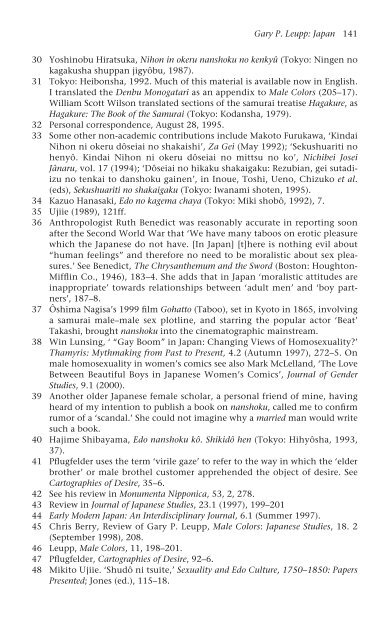queer masculinities
queer masculinities
queer masculinities
Create successful ePaper yourself
Turn your PDF publications into a flip-book with our unique Google optimized e-Paper software.
Gary P. Leupp: Japan 141<br />
30 Yoshinobu Hiratsuka, Nihon in okeru nanshoku no kenkyû (Tokyo: Ningen no<br />
kagakusha shuppan jigyôbu, 1987).<br />
31 Tokyo: Heibonsha, 1992. Much of this material is available now in English.<br />
I translated the Denbu Monogatari as an appendix to Male Colors (205–17).<br />
William Scott Wilson translated sections of the samurai treatise Hagakure, as<br />
Hagakure: The Book of the Samurai (Tokyo: Kodansha, 1979).<br />
32 Personal correspondence, August 28, 1995.<br />
33 Some other non-academic contributions include Makoto Furukawa, ‘Kindai<br />
Nihon ni okeru dôseiai no shakaishi’, Za Gei (May 1992); ‘Sekushuariti no<br />
henyô. Kindai Nihon ni okeru dôseiai no mittsu no ko’, Nichibei Josei<br />
Jânaru, vol. 17 (1994); ‘Dôseiai no hikaku shakaigaku: Rezubian, gei sutadiizu<br />
no tenkai to danshoku gainen’, in Inoue, Toshi, Ueno, Chizuko et al.<br />
(eds), Sekushuariti no shakaigaku (Tokyo: Iwanami shoten, 1995).<br />
34 Kazuo Hanasaki, Edo no kagema chaya (Tokyo: Miki shobô, 1992), 7.<br />
35 Ujiie (1989), 121ff.<br />
36 Anthropologist Ruth Benedict was reasonably accurate in reporting soon<br />
after the Second World War that ‘We have many taboos on erotic pleasure<br />
which the Japanese do not have. [In Japan] [t]here is nothing evil about<br />
“human feelings” and therefore no need to be moralistic about sex pleasures.’<br />
See Benedict, The Chrysanthemum and the Sword (Boston: Houghton-<br />
Mifflin Co., 1946), 183–4. She adds that in Japan ‘moralistic attitudes are<br />
inappropriate’ towards relationships between ‘adult men’ and ‘boy partners’,<br />
187–8.<br />
37 Ôshima Nagisa’s 1999 film Gohatto (Taboo), set in Kyoto in 1865, involving<br />
a samurai male–male sex plotline, and starring the popular actor ‘Beat’<br />
Takashi, brought nanshoku into the cinematographic mainstream.<br />
38 Win Lunsing, ‘ “Gay Boom” in Japan: Changing Views of Homosexuality?’<br />
Thamyris: Mythmaking from Past to Present, 4.2 (Autumn 1997), 272–5. On<br />
male homosexuality in women’s comics see also Mark McLelland, ‘The Love<br />
Between Beautiful Boys in Japanese Women’s Comics’, Journal of Gender<br />
Studies, 9.1 (2000).<br />
39 Another older Japanese female scholar, a personal friend of mine, having<br />
heard of my intention to publish a book on nanshoku, called me to confirm<br />
rumor of a ‘scandal.’ She could not imagine why a married man would write<br />
such a book.<br />
40 Hajime Shibayama, Edo nanshoku kô. Shikidô hen (Tokyo: Hihyôsha, 1993,<br />
37).<br />
41 Pflugfelder uses the term ‘virile gaze’ to refer to the way in which the ‘elder<br />
brother’ or male brothel customer apprehended the object of desire. See<br />
Cartographies of Desire, 35–6.<br />
42 See his review in Monumenta Nipponica, 53, 2, 278.<br />
43 Review in Journal of Japanese Studies, 23.1 (1997), 199–201<br />
44 Early Modern Japan: An Interdisciplinary Journal, 6.1 (Summer 1997).<br />
45 Chris Berry, Review of Gary P. Leupp, Male Colors: Japanese Studies, 18. 2<br />
(September 1998), 208.<br />
46 Leupp, Male Colors, 11, 198–201.<br />
47 Pflugfelder, Cartographies of Desire, 92–6.<br />
48 Mikito Ujiie. ‘Shudô ni tsuite,’ Sexuality and Edo Culture, 1750–1850: Papers<br />
Presented; Jones (ed.), 115–18.


